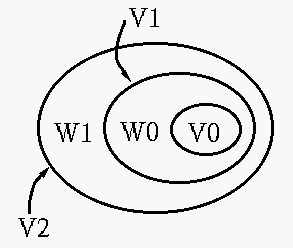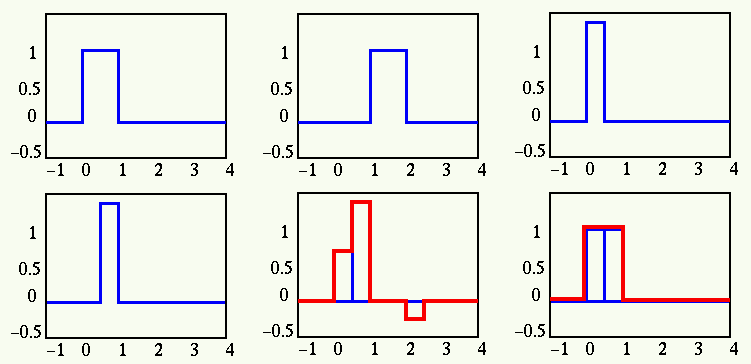Consider a set of functions
Corresponding to a specific index ![]() , a subset of functions
, a subset of functions
![]() spans a function space
spans a function space ![]() . In
general, there are many such functions spaces:
. In
general, there are many such functions spaces:
![]() .
.
If a family of functions
![]() satisfy the follow requirements, they
become a set of basis functions that span a function space, so that a given function
satisfy the follow requirements, they
become a set of basis functions that span a function space, so that a given function
![]() can be represented as a linear combination of these bases:
can be represented as a linear combination of these bases:

Functions satisfying these requirements are called scaling functions. As
the basis functions, a subset of scaling functions ![]() with a certain
scale
with a certain
scale ![]() can only represent a function
can only represent a function ![]() up to a certain level of details
corresponding to the scale of the bases. All details in
up to a certain level of details
corresponding to the scale of the bases. All details in ![]() finer than the limit
of the scales of
finer than the limit
of the scales of ![]() are lost. However, such details can be better
represented by the basis functions of the next higher scale
are lost. However, such details can be better
represented by the basis functions of the next higher scale
![]() .
In general, space
.
In general, space ![]() contains all functions representable in
contains all functions representable in ![]() , as
well as those functions with more details not representable in
, as
well as those functions with more details not representable in ![]() , i.e.,
, i.e.,
![]() , and a function can always be more precisely represented
by increasing the scales (the parameter
, and a function can always be more precisely represented
by increasing the scales (the parameter ![]() ) of the bases.
) of the bases.

Note: The nested relations between the sequence of subspaces shown above
is closely related to the Gaussian-Laplacian pyramid discussed earlier. Essentially
they both state that a signal can be decomposed into a set of components each
representing details of different levels contained in the signal. The images in
the Laplacian pyramid correspond to the subspaces ![]() as they both represent
the difference between two consecutive levels of details.
as they both represent
the difference between two consecutive levels of details.
The basis functions
![]() are themselves members of the space
are themselves members of the space ![]() they span as well as all the super-spaces:
they span as well as all the super-spaces:

The first 4 panels show the scaling functions:
![]() ,
,
![]() ,
,
![]() , and
, and
![]() , The 5th panel shows a function in
space
, The 5th panel shows a function in
space ![]() spanned by
spanned by
![]() . The 6th panel shows
. The 6th panel shows
![]() as a special function in space
as a special function in space ![]() .
.
Example: The Haar scaling function at level ![]() is defined as a square
pulse of unit width and unit height:
is defined as a square
pulse of unit width and unit height:

Moreover, the Haar scaling functions in space ![]() are also functions in space
are also functions in space
![]() and they can be expressed as a linear combination of the basis functions
and they can be expressed as a linear combination of the basis functions
![]() :
:
![\begin{displaymath}\varphi(t)=\varphi_{0,0}(t)=h_{\varphi}[0]\sqrt{2}\varphi_{0,...
...0,0}(2t-1)
=\sum_{l=0}^1 h_{\varphi}[l] \sqrt{2}\varphi(2t-l) \end{displaymath}](img93.png)